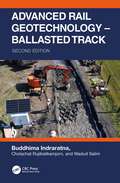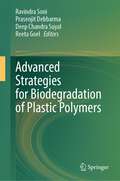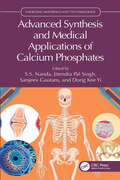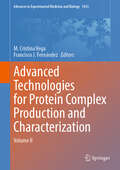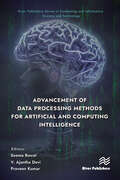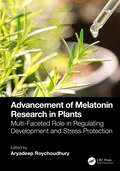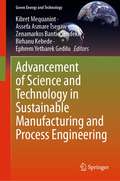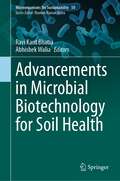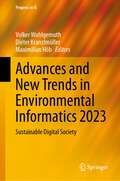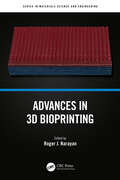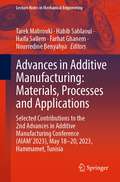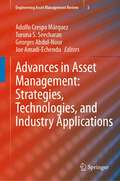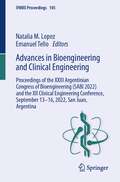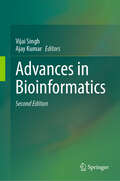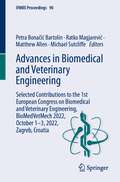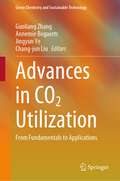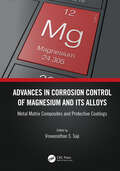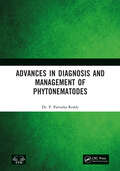- Table View
- List View
Advanced Rail Geotechnology – Ballasted Track
by Buddhima Indraratna Cholachat Rujikiatkamjorn Wadud SalimBallast plays a vital role in transmitting and distributing the train wheel loads to the underlying track substructure. The load-bearing capacity, safe train speed, and the levels of noise and vibration, as well as passenger comfort depend on the behaviour of ballast through particle interlocking and the corresponding deformation of this granular assembly. Attrition and breakage of ballast occur progressively under heavy and continual cyclic loading, causing track deterioration and rail misalignment affecting safety, while exacerbating the intensity of track maintenance. In the absence of realistic computational models, the track substructure is traditionally designed using mostly empirical approaches. In this book, the authors present the detailed information on the strength, deformation, and degradation aspects of fresh and recycled ballast under monotonic, cyclic, and impact loading using innovative geotechnical testing devices. A constitutive model for ballast incorporating particle breakage is presented representing a more realistic stress–strain response. The mathematical formulations and numerical models are validated using controlled experimental simulations and fully instrumented field trials. Revised ballast gradation is described to provide greater track resiliency and extended longevity. The book also provides a detailed description of geosynthetics for substructure improvement considering track deterioration caused by particle degradation, fouling, and impeded drainage. New to this second edition are extensive discussions on subgrade soil stabilisation, causes and mechanisms of soil fluidisation (mud pumping) under cyclic loading, and preventive and remedial measures to alleviate undue instability of ballast tracks. This book should prove most beneficial for final-year civil engineering students and for postgraduate teaching and learning. It is an ideal supplement for practising railway engineers and researchers engaged in the challenging tasks of future track design for heavier and faster trains.
Advanced Rail Geotechnology – Ballasted Track
by Buddhima Indraratna Cholachat Rujikiatkamjorn Wadud SalimBallast plays a vital role in transmitting and distributing the train wheel loads to the underlying track substructure. The load-bearing capacity, safe train speed, and the levels of noise and vibration, as well as passenger comfort depend on the behaviour of ballast through particle interlocking and the corresponding deformation of this granular assembly. Attrition and breakage of ballast occur progressively under heavy and continual cyclic loading, causing track deterioration and rail misalignment affecting safety, while exacerbating the intensity of track maintenance. In the absence of realistic computational models, the track substructure is traditionally designed using mostly empirical approaches. In this book, the authors present the detailed information on the strength, deformation, and degradation aspects of fresh and recycled ballast under monotonic, cyclic, and impact loading using innovative geotechnical testing devices. A constitutive model for ballast incorporating particle breakage is presented representing a more realistic stress–strain response. The mathematical formulations and numerical models are validated using controlled experimental simulations and fully instrumented field trials. Revised ballast gradation is described to provide greater track resiliency and extended longevity. The book also provides a detailed description of geosynthetics for substructure improvement considering track deterioration caused by particle degradation, fouling, and impeded drainage. New to this second edition are extensive discussions on subgrade soil stabilisation, causes and mechanisms of soil fluidisation (mud pumping) under cyclic loading, and preventive and remedial measures to alleviate undue instability of ballast tracks. This book should prove most beneficial for final-year civil engineering students and for postgraduate teaching and learning. It is an ideal supplement for practising railway engineers and researchers engaged in the challenging tasks of future track design for heavier and faster trains.
Advanced Strategies for Biodegradation of Plastic Polymers
by Ravindra Soni Prasenjit Debbarma Deep Chandra Suyal Reeta GoelSynthetic plastic offers a wide range of utilities because of its physico-chemical properties, thus the demand for its commercial availability and generation of waste is inevitable. Although the scientists have proved over the years that plastics can be efficiently biodegraded by different potential microorganisms, this sustainable green technology is still in the cocoon phase and overlooked by the industry and government as well. Therefore, this book will showcase the cutting-edge microbial tools to mitigate the plastic waste sustainably in consideration of latest technologies and recent strategic advancements besides discussing the global plastic production and their impacts on environment. It will also provide the present status and future perspectives of the environmental clean-up technologies. Moreover, it is an effort to ascertain the potential areas for large-scale biodegradation or pilot scale or start-up ventures in the field of plastic remediation strategy.
Advanced Synthesis and Medical Applications of Calcium Phosphates (Emerging Materials and Technologies)
Calcium phosphate materials are used in many medical and dental applications. Advanced Synthesis and Medical Applications of Calcium Phosphates covers the structure, chemistry, synthesis, and properties of both natural and synthetic calcium-based biomaterials and details a variety of medical applications. Depicts the latest advances in using calcium phosphates in bone regeneration and tissue engineering Includes the latest generation of regenerative biomaterials with an integrated perspective combining both research and clinical issues Provides an understanding of the clinical targets and requirements for regenerative medicine Detailing fundamentals through applications, this book helps biomaterials researchers to better understand the clinical targets and requirements for use of these materials for optimal synthesis and development.
Advanced Synthesis and Medical Applications of Calcium Phosphates (Emerging Materials and Technologies)
by S. S. Nanda Jitendra Pal Singh Sanjeev Gautam Dong Kee YiCalcium phosphate materials are used in many medical and dental applications. Advanced Synthesis and Medical Applications of Calcium Phosphates covers the structure, chemistry, synthesis, and properties of both natural and synthetic calcium-based biomaterials and details a variety of medical applications. Depicts the latest advances in using calcium phosphates in bone regeneration and tissue engineering Includes the latest generation of regenerative biomaterials with an integrated perspective combining both research and clinical issues Provides an understanding of the clinical targets and requirements for regenerative medicine Detailing fundamentals through applications, this book helps biomaterials researchers to better understand the clinical targets and requirements for use of these materials for optimal synthesis and development.
Advanced Technologies for Protein Complex Production and Characterization: Volume II (Advances in Experimental Medicine and Biology #1453)
by M. Cristina Vega Francisco J. FernándezThis edited volume discusses the identification, discovery, characterization, structure determination and modeling of multicomponent macromolecular complexes, and as such, it fully complements the first volume (ISBN 978-3-319-27214-6), which targeted methods of recombinant production of protein complexes. This book is divided in 8 sections offering a selection of technologies widely used in the characterization of protein and protein-nucleic acid complexes for different purposes and at different scales. From native electrophoresis methods, that are accessible to any reasonably well-equipped laboratory, to the sophisticated setup required for structure determination by cryo-electron microscopy or X-ray crystallography, this book contains a wide variety of clearly explained analytic and preparative approaches, connected with the production techniques developed on the previous volume. The readers will find an integral connection between this book and the first volume, which ensures a comprehensive and updated discussion of the main topics of the discipline. Taken together, these volumes constitute a cohesive and authoritative source of the research on multicomponent macromolecular complexes. In here, we focus on characterization of protein complexes in the broadest sense, which is not typically covered in other sources. Moreover, all chapters are carefully written by world renowned scientists and active researchers, making this volume ideal, not only as a reference source, but also as a companion book for the daily laboratory work. This book is aimed for a wide range of scientists, from science students to experienced researchers, working on protein and protein-nucleic acid complexes, who need a thorough understanding of protein production and complex characterization.
Advancement of Data Processing Methods for Artificial and Computing Intelligence (River Publishers Series in Computing and Information Science and Technology)
by Seema Rawat V. Ajantha Devi Praveen KumarThis book emphasizes the applications of advances in data processing methods for Artificial Intelligence in today's fast-changing world, as well as to serve society through research, innovation, and development in this field. This book is applicable to a wide range of data that contribute to data science concerns and can be used to promote research in this high-potential new field. People's perceptions of the world and how they conduct their lives have changed dramatically as a result of technological advancements. The world has been gripped by technology, and the advances that are being made every day are undeniably transforming the planet. In the domains of Big Data, engineering, and data science, this cutting-edge technology is ready to support us.Artificial intelligence (AI) is a current research topic because it can be applied to a wide range of applications and disciplines to solve complicated problems and find optimal solutions. In research, medicine, technology, and the social sciences, the benefits of AI have already been proven. Data science, also known as pattern analytics and mining, is a technique for extracting useful and relevant information from databases, enabling better decision-making and strategy formulation in a range of fields. As a result of the exponential growth of data in recent years, the combined notions of big data and AI have given rise to many study areas, such as scale-up behaviour from classical algorithms. Furthermore, combining numerous AI technologies from other areas (such as vision, security, control, and biology) in order to build efficient and durable systems that interact in the real world is a new problem. Despite recent improvements in fundamental AI technologies, the integration of these skills into larger, trustworthy, transparent, and maintainable systems is still in its development. Both conceptually and practically, there are a number of unanswered issues.
Advancement of Data Processing Methods for Artificial and Computing Intelligence (River Publishers Series in Computing and Information Science and Technology)
This book emphasizes the applications of advances in data processing methods for Artificial Intelligence in today's fast-changing world, as well as to serve society through research, innovation, and development in this field. This book is applicable to a wide range of data that contribute to data science concerns and can be used to promote research in this high-potential new field. People's perceptions of the world and how they conduct their lives have changed dramatically as a result of technological advancements. The world has been gripped by technology, and the advances that are being made every day are undeniably transforming the planet. In the domains of Big Data, engineering, and data science, this cutting-edge technology is ready to support us.Artificial intelligence (AI) is a current research topic because it can be applied to a wide range of applications and disciplines to solve complicated problems and find optimal solutions. In research, medicine, technology, and the social sciences, the benefits of AI have already been proven. Data science, also known as pattern analytics and mining, is a technique for extracting useful and relevant information from databases, enabling better decision-making and strategy formulation in a range of fields. As a result of the exponential growth of data in recent years, the combined notions of big data and AI have given rise to many study areas, such as scale-up behaviour from classical algorithms. Furthermore, combining numerous AI technologies from other areas (such as vision, security, control, and biology) in order to build efficient and durable systems that interact in the real world is a new problem. Despite recent improvements in fundamental AI technologies, the integration of these skills into larger, trustworthy, transparent, and maintainable systems is still in its development. Both conceptually and practically, there are a number of unanswered issues.
Advancement of Melatonin Research in Plants: Multi-Faceted Role in Regulating Development and Stress Protection
by Aryadeep RoychoudhuryMelatonin (N-acetyl-5-methoxytryptamine) is a widely studied biomolecule, and its function has been investigated in bacteria, mammals, birds, amphibians, reptiles, fish and plants. Melatonin research in plants the last five years has attained an exponential growth phase and the number of publications related to phytomelatonin has significantly increased in present times. All this research is directed towards establishing multifarious roles of melatonin in plants, including the promotion of seed germination and seedling growth, influencing plant development and senescence, alteration of flowering and fruiting time and grain yield, modulating circadian rhythms, improving resistance against biotic stress as well as tolerance to abiotic stress, reducing oxidative stress, and stimulating plant immune response. However, to date, an exhaustive book, solely and exclusively dedicated to melatonin research on various aspects of plant biology, has not been published by any renowned publisher or is available in the market. Keeping all these facts in mind, this book aims to compile the most recent developments in the arena of melatonin-mediated regulation of plant physiology under optimal and sub-optimal conditions. This book will initiate and introduce the readers to the state-of-the-art developments and trends in this field of study and will largely cater to the scientific need of scientists engaged in melatonin research across the globe. The book will be unique of its kind and will draw the attention of scientific and research communities engaged in the field of melatonin research.The key features of this book: Authors will address the topics which would provide advances in the understanding of diverse functions of melatonin in plants, encompassing almost all the aspects that have been investigated so far Integrate the overall mechanistic function of melatonin, genomics and proteomics tools, and genetic engineering to manipulate endogenous melatonin levels, thus giving a holistic view of plant-level studies under normal or challenging situations Largely help the readers to design future research programs in exploiting melatonin as a protective agent to develop climate-resilient and pathogen-resistant plants Benefit the crop protection program and ensure food security Chapters will be supplemented with ample illustrations and figures This book will be beneficial to research scholars and Ph.D. students involved in melatonin research and working on stress physiology, stress proteins, genomics, proteomics and genetic engineering in different universities and research institutes all over the world. The book can also be used as an advanced reference book for the coursework of research and master’s level students. It will be of use to people involved in improving plant growth and yield, as well as the performance of plant species in the face of climate change and pathogen infection, using melatonin as the prime protective agent and signaling molecule. Although the book will directly benefit the academic and scientific community, it will also indirectly draw the attention of industries or companies that manufacture or sell chemical products, since the book will highlight in detail the antioxidative potential of melatonin. This will create impetus at the industrial level for the isolation and synthesis of melatonin as a beneficial chemical agent. Applying melatonin as an ameliorating agent against different stresses at the field level will also increase the demand for this chemical among the farmers and will promote large-scale sales and utilization of melatonin for ensuring crop protection and increasing yield.
Advancement of Melatonin Research in Plants: Multi-Faceted Role in Regulating Development and Stress Protection
by Aryadeep RoychoudhuryMelatonin (N-acetyl-5-methoxytryptamine) is a widely studied biomolecule, and its function has been investigated in bacteria, mammals, birds, amphibians, reptiles, fish and plants. Melatonin research in plants the last five years has attained an exponential growth phase and the number of publications related to phytomelatonin has significantly increased in present times. All this research is directed towards establishing multifarious roles of melatonin in plants, including the promotion of seed germination and seedling growth, influencing plant development and senescence, alteration of flowering and fruiting time and grain yield, modulating circadian rhythms, improving resistance against biotic stress as well as tolerance to abiotic stress, reducing oxidative stress, and stimulating plant immune response. However, to date, an exhaustive book, solely and exclusively dedicated to melatonin research on various aspects of plant biology, has not been published by any renowned publisher or is available in the market. Keeping all these facts in mind, this book aims to compile the most recent developments in the arena of melatonin-mediated regulation of plant physiology under optimal and sub-optimal conditions. This book will initiate and introduce the readers to the state-of-the-art developments and trends in this field of study and will largely cater to the scientific need of scientists engaged in melatonin research across the globe. The book will be unique of its kind and will draw the attention of scientific and research communities engaged in the field of melatonin research.The key features of this book: Authors will address the topics which would provide advances in the understanding of diverse functions of melatonin in plants, encompassing almost all the aspects that have been investigated so far Integrate the overall mechanistic function of melatonin, genomics and proteomics tools, and genetic engineering to manipulate endogenous melatonin levels, thus giving a holistic view of plant-level studies under normal or challenging situations Largely help the readers to design future research programs in exploiting melatonin as a protective agent to develop climate-resilient and pathogen-resistant plants Benefit the crop protection program and ensure food security Chapters will be supplemented with ample illustrations and figures This book will be beneficial to research scholars and Ph.D. students involved in melatonin research and working on stress physiology, stress proteins, genomics, proteomics and genetic engineering in different universities and research institutes all over the world. The book can also be used as an advanced reference book for the coursework of research and master’s level students. It will be of use to people involved in improving plant growth and yield, as well as the performance of plant species in the face of climate change and pathogen infection, using melatonin as the prime protective agent and signaling molecule. Although the book will directly benefit the academic and scientific community, it will also indirectly draw the attention of industries or companies that manufacture or sell chemical products, since the book will highlight in detail the antioxidative potential of melatonin. This will create impetus at the industrial level for the isolation and synthesis of melatonin as a beneficial chemical agent. Applying melatonin as an ameliorating agent against different stresses at the field level will also increase the demand for this chemical among the farmers and will promote large-scale sales and utilization of melatonin for ensuring crop protection and increasing yield.
Advancement of Science and Technology in Sustainable Manufacturing and Process Engineering (Green Energy and Technology)
by Kibret Mequanint Assefa Asmare Tsegaw Zenamarkos Bantie Sendekie Birhanu Kebede Ephrem Yetbarek GediluThis book presents current research on sustainable development issues and recent manufacturing and process engineering advances. Topics covered range from postharvest technologies to sustainable utilization of natural resources and supply chain integration to the design of renewable energy systems. The book provides researchers, engineers, industry professionals, graduate students, and practitioners with state-of-the-art research on the efforts being made toward sustainability in developing countries.
Advancements in Microbial Biotechnology for Soil Health (Microorganisms for Sustainability #50)
by Ravi Kant Bhatia Abhishek WaliaThis edited book covers the latest trends to improve soil health. It provides an easy-to-understand information to the readers. This book acts as a reference book for various agronomists and research scholars working in the field of agriculture. This edited book covers advanced technologies and practices carried out worldwide to improve soil health. In the present scenario, it is very important to save soil health and replenish it in a sustainable manner from various anthropogenic hazards. As soil is the source to almost all lives on earth and it is duty, the scientific community is developing ways to disseminate and communicate the most recent advancements to restore its health. Content of the book is designed in such a way that it provides a compressive information to the readers to restore the soil health that will ultimately help to improve the health of microbes, animals as well as plants that thrive in the soil and ultimately the quality of life of human being. This book helpsresearch scholars and teachers working in agriculture, horticulture, and environmental management by utilizing advances in microbiology and biotechnology. It is of interest to undergraduate and graduate students, teachers, researchers, environmentalists, agriculture and horticulture scientists, capacity builders, policy makers and all other stakeholders.
Advances and New Trends in Environmental Informatics 2023: Sustainable Digital Society (Progress in IS)
by Volker Wohlgemuth Dieter Kranzlmüller Maximilian HöbThis book is an outcome of the 37th International Conference EnviroInfo 2023, held at the Leibniz Supercomputing Centre (Munich, Germany), organized by the technical committee for Environmental Informatics of the German Informatics Society. It explores the fusion of information and communication technologies with environmental sustainability. As a flagship edition of the EnviroInfo conference series, it showcases the latest advancements in applied informatics and environmental informatics. With a focus on "Towards a Sustainable Digital Society," the conference presents innovative research on topics such as green computing, sustainable software engineering, and digital transformation. The proceedings cover essential subjects for shaping a greener future, including energy-efficient workloads, environmental management systems, legal frameworks, Earth observation, and geographical information systems. It also examines emerging technologies like robotics, AI, and reinforcement learning, highlighting their applications in environmental informatics. From citizen science to disaster risk modeling and sustainable resource management, the book explores the interdisciplinary nature of environmental informatics. It also addresses societal aspects, including its role in developing countries. This resource is essential for researchers, professionals, and policymakers seeking to leverage ICT for addressing environmental challenges and building a sustainable digital society.
Advances in 3D Bioprinting (Series in Materials Science and Engineering)
by Roger J. Narayan"3D bioprinting" refers to processes in which an additive manufacturing approach is used to create devices for medical applications. This volume considers exciting applications for 3D bioprinting, including its use in manufacturing artificial tissues, surgical models, and orthopedic implants.The book includes chapters from leaders in the field on 3D bioprinting of tissues and organs, biomedical applications of digital light processing, biomedical applications of nozzle-free pyro-electrohydrodynamic jet printing of buffer-free bioinks, additive manufacturing of surgical models, dental crowns, and orthopedic implants, 3D bioprinting of dry electrodes, and 3D bioprinting for regenerative medicine and disease modeling of the ocular surface.This is an accessible reference for students and researchers on current 3D bioprinting technology, providing helpful information on the important applications of this technology. It will be a useful resource to students, researchers, and practitioners in the rapidly growing global 3D bioprinting community.
Advances in 3D Bioprinting (Series in Materials Science and Engineering)
by Roger J. Narayan"3D bioprinting" refers to processes in which an additive manufacturing approach is used to create devices for medical applications. This volume considers exciting applications for 3D bioprinting, including its use in manufacturing artificial tissues, surgical models, and orthopedic implants.The book includes chapters from leaders in the field on 3D bioprinting of tissues and organs, biomedical applications of digital light processing, biomedical applications of nozzle-free pyro-electrohydrodynamic jet printing of buffer-free bioinks, additive manufacturing of surgical models, dental crowns, and orthopedic implants, 3D bioprinting of dry electrodes, and 3D bioprinting for regenerative medicine and disease modeling of the ocular surface.This is an accessible reference for students and researchers on current 3D bioprinting technology, providing helpful information on the important applications of this technology. It will be a useful resource to students, researchers, and practitioners in the rapidly growing global 3D bioprinting community.
Advances in Additive Manufacturing: Selected Contributions to the 2nd Advances in Additive Manufacturing Conference (AIAM' 2023), May 18–20, 2023, Hammamet, Tunisia (Lecture Notes in Mechanical Engineering)
by Tarek Mabrouki Habib Sahlaoui Haifa Sallem Farhat Ghanem Nourredine BenyahyaThis book reports on research and developments in the field of 3D printing, with a special emphasis on methods to analyse the products of additive manufacturing, and optimize different steps of the manufacturing process. Gathering selected contributions to the 2nd Advances in Additive Manufacturing Conference (AIAM' 2023), held on Mai 18-20, 2023, in Hammamet, Tunisia, this book covers a variety of topics, including: analysis of microstructure and material behavior, numerical simulation and model techniques for optimization of manufacturing processes, machine learning for quality control and automated monitoring, among others. Offering a good balance of fundamental research and industrially relevant findings, this book provides researchers and professionals with a timely snapshot of and extensive information on current developments in the field and a source of inspiration for future research and collaboration.
Advances in Asset Management: Strategies, Technologies, and Industry Applications (Engineering Asset Management Review #3)
by Adolfo Crespo Márquez Turuna S. Seecharan Georges Abdul-Nour Joe Amadi-EchenduThis book discusses asset life-cycle management, especially, human dimensions on the management of infrastructure and industry-sector assets. The book explores advances decision support systems based on the applications of Fourth Industrial Revolution (4IR) technologies such as augmented reality (AR) and virtual reality (VR), machine learning, and digital twinning for monitoring, diagnostics, prognostics. It includes methodologies and cases applied to different operational contexts. The book also considers the implications of the applications of international standards, local regulations and industry guidelines to risk and resilience engineering asset operations.
Advances in Bioengineering and Clinical Engineering: Proceedings of the XXIII Argentinian Congress of Bioengineering (SABI 2022) and the XII Clinical Engineering Conference, September 13–16, 2022, San Juan, Argentina (IFMBE Proceedings #105)
by Natalia M. Lopez Emanuel TelloThis book offers a timely snapshot of research, technologies and best practices in the broad area of bioengineering and clinical engineering. Contributions report on advances in biomechanics, biomaterials, and tissue engineering, biosensors and instrumentation, biomedical signal processing, and rehabilitation engineering. Further, it covers topics relating to quality engineering and management of health services, and of engineering education. The book gathers selected, peer-reviewed contributions to the XXIII Argentinian Congress of Bioengineering and the XII Clinical Engineering Conference, both known under the acronym “SABI 2022”, held on September 13–16, 2022, in San Juan, Argentina, and organized by the Sociedad Argentina de Bioingeniería.
Advances in Bioinformatics
by Vijai Singh Ajay KumarThe second edition of Advances in Bioinformatics presents the latest developments in bioinformatics in gene discovery, genome analysis, genomics, transcriptomics, proteomics, metabolomics, metabolic flux analysis, drug discovery, and drug repurposing. It includes advancements in the applications of bioinformatics in the analysis of non-coding RNA, next-generation sequencing, genome-scale modelling, high throughput drug screening, precision medicine, automation and artificial intelligence, and machine learning. The chapter also summarizes the technologies and concepts that form the basis of this functional genomics approach. Additionally, the book highlights some of the areas in which bioinformatics resources and methods are being developed to support the drug discovery pipeline. The chapter also discusses the role of bioinformatics in modelling and simulations of molecular biology systems in pathways identification and design. It is a valuable source of information for beginners in bioinformatics and students, researchers, scientists, clinicians, practitioners, policymakers, and stakeholders who are interested in harnessing the potential of bioinformatics in biomedical and allied sciences.
Advances in Biomedical and Veterinary Engineering: Selected Contributions to the 1st European Congress on Biomedical and Veterinary Engineering, BioMedVetMech 2022, October 1–3, 2022, Zagreb, Croatia (IFMBE Proceedings #90)
by Petra Bonačić Bartolin Ratko Magjarević Matthew Allen Michael SutcliffeThis book gathers selected peer-reviewed contributions to the 1st European Congress on Biomedical and Veterinary Engineering, BioMedVetMech 2022, held on October 1–3, 2022, in Zagreb, Croatia. It offers a timely snapshot of research findings and advances technologies in the area of biomechanics, rehabilitation and surgery. It covers applications of brain-computer interface, virtual reality and functional electrical stimulation, among others.
Advances in CO2 Utilization: From Fundamentals to Applications (Green Chemistry and Sustainable Technology)
by Guoliang Zhang Annemie Bogaerts Jingyun Ye Chang-Jun LiuThis book presents the current status of CO2 utilization from fundamental studies to industrial tests. With the development of renewable energy, carbon dioxide will become an important feedstock for the synthesis of fuels and chemicals, and CO2 utilization must be the final solution for the carbon dioxide issues. This book discusses the effective techniques for activating inert carbon dioxide and various approaches for CO2 conversion, such as homogeneous catalytic conversion, homogeneous catalytic conversion, heterogeneous catalytic conversion, photocatalytic conversion, electrocatalytic conversion, photo-thermal catalytic conversion, plasma-chemical/plasma-catalytic conversion, and bio-catalytic conversion. It also addresses the electronic and geometric structural effects of the supported catalyst on the activity and selectivity of the conversion of carbon dioxide. The significant effects from single atom catalyst to nanoparticle are also discussed, and process intensification in catalyst preparation and reaction is highlighted. Furthermore, this book contains chapters with theoretical studies, including functional theory, which has played an important role in the catalyst design, the explanation of the reaction mechanism, and in understanding the synergy of reaction and heat and mass transfer. Given its scope, this book appeals to a wider readership, especially for researchers in the field of CO2 utilization.
Advances in Corrosion Control of Magnesium and its Alloys: Metal Matrix Composites and Protective Coatings
Magnesium (Mg) and its alloys have received widespread acceptance in automobile industries and biomedical applications with substantial recent advancements made in their development, however a significant limitation remains their poor aqueous and galvanic corrosion resistance. This book covers both the fundamentals and recent advancements in two major corrosion protection strategies of magnesium and its alloys, namely, metal-matrix composites and protective coatings.Key features: Covers all aspects of metal-matrix composites and protective coatings for magnesium alloys to improve their corrosion resistance, wear resistance, mechanical properties and biocompatibility Provides the most recent research advancements in the corrosion mitigation strategies of magnesium and its alloys Complete with case studies specific to practical applications, this book serves as a ready reference for graduate students, researchers, engineers and industry professionals in the fields of materials, corrosion science, biofouling and protective coatings.
Advances in Corrosion Control of Magnesium and its Alloys: Metal Matrix Composites and Protective Coatings
by Viswanathan S. SajiMagnesium (Mg) and its alloys have received widespread acceptance in automobile industries and biomedical applications with substantial recent advancements made in their development, however a significant limitation remains their poor aqueous and galvanic corrosion resistance. This book covers both the fundamentals and recent advancements in two major corrosion protection strategies of magnesium and its alloys, namely, metal-matrix composites and protective coatings.Key features: Covers all aspects of metal-matrix composites and protective coatings for magnesium alloys to improve their corrosion resistance, wear resistance, mechanical properties and biocompatibility Provides the most recent research advancements in the corrosion mitigation strategies of magnesium and its alloys Complete with case studies specific to practical applications, this book serves as a ready reference for graduate students, researchers, engineers and industry professionals in the fields of materials, corrosion science, biofouling and protective coatings.
Advances in Diagnosis and Management of Phytonematodes
by P. Parvatha ReddyAdvances in Diagnosis and Management of Phytonematodes provides information on various aspects of diagnosis and eco-friendly nematode management. It explains at length nematode diagnosis—morphological, biochemical and molecular—and management strategies—regulatory, physical, cultural, chemical, biological, host resistance and integrated management methods. This book will be of immense value to the scientific community involved in teaching, research and extension activities related to the diagnosis and management of phytonematodes. It is suitable for teaching both undergraduate and postgraduate courses in the field of plant protection. It can also serve as an advantageous reference to policymakers and practicing farmers. Print edition not for sale in India.
Advances in Diagnosis and Management of Phytonematodes
by P. Parvatha ReddyAdvances in Diagnosis and Management of Phytonematodes provides information on various aspects of diagnosis and eco-friendly nematode management. It explains at length nematode diagnosis—morphological, biochemical and molecular—and management strategies—regulatory, physical, cultural, chemical, biological, host resistance and integrated management methods. This book will be of immense value to the scientific community involved in teaching, research and extension activities related to the diagnosis and management of phytonematodes. It is suitable for teaching both undergraduate and postgraduate courses in the field of plant protection. It can also serve as an advantageous reference to policymakers and practicing farmers. Print edition not for sale in India.
